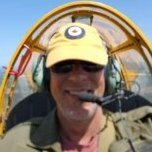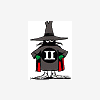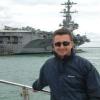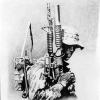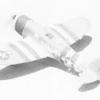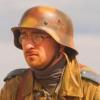Search the Community
Showing results for tags 'Corsair'.
-
Just an amazing kit and I've built almost every Tamiya aircraft. The fit was perfect in every aspect with many parts clicking into place. The whole thing was painted, decalled and washes applied in sub assemblies before bring together in the end. WIP thread is here: http://www.britmodeller.com/forums/index.php?/topic/234955962-1-32-f4u-1-april-1-finished/ Commments/critiques welcome.
- 20 replies
-
- 13
-

-
Here is another one started - this will be strictly OOB as it is for Tamiya Canada. I think the cockpit is done... These are the included belts. yes they are very stiff material but they can be manipulated into place. I know the new fabric style would be better but these are good for "standard equipment". The engine so far... After an airbrush of X-18 semi-gloss black it was dry brushed heavily with Humbrol flat aluminum. Washes next. more to come... Bill B.
- 33 replies
-
- 12
-

-

Brassin F4U-1 Corsair Wheels. 1:32 Brassin
Shar2 posted a topic in Aftermarket (updates/conversions)
F4U-1 Corsair Wheels 1:32 Brassin To replace the rubber tyres in the Tamiya Corsair kit, Eduard/Brassin have released this set of resin parts. The parts come in the standard blister pack with two layers of foam protecting them. On opening the quality of parts really stands out. The wheels, with their distinctive treads, are beautifully moulded with great depth of the internal vanes. The holes between the vanes will need to be carefully cleaned up as there is a thin veil of resin flash over them. Clean up of the wheels should be quick and easy as the webs holding them to the moulding blocks are very thin. Any excess left after removal will only require a quick swipe of a sanding stick to tidy up. Also included in the set are the inner hubs, with brake details and attachment holes that match the kit axles. The outer hubs with their spokes will also need to be carefully cleaned up as the triangular holes between the spokes are also flashed over, but the flash is quite a bit thicker than on the wheels. This looks like it will be quite a tricky job, but will be worth it in the end. Fortunately it will be easier to paint the wheels as there is nice mask sheet included in the pack. Conclusion You can’t really go wrong with Brassin and this set goes a long way to prove it. It’s not perfect mind, as the flashed over holes in the wheels and especially the outer hubs, really shouldn’t be there with modern tooling, even in resin. Other than that I can happily recommend them. Review sample courtesy of -
Just finished this today, first completed build of the year. Italeri 1/72 F4U-7 in French Navy markings from the Suez Crisis. Pretty much built OOB, added brass tube gun barrels as the kit ones were a bit soft, tape belts, nitinol radio wires and made the navigation lights out of clear sprue, a first for me and they came out alright. Painted the stripes and the tricolour on the tail even though they are supplied as decals. The kit decals aren't great and if I made another I would replace them. They are a bit translucent and take forever to loosen from the backing paper. The fit of the rockets is a little clubby, not sure if the fins are too long or the stubs need spacing out more. Other than that the kit goes together very nicely and I'm tempted to get another one and do it as a very tatty French bird from Algeria or maybe an Argentine Navy one. Cheers Segan
-
I plan on converting my Trumpeter 1/32 F4U-4 Corsair into the F4U-4B version, with the 4 20mm cannon. I need some accurate drawings of the top & bottom of the wings, so I can get the panel line differences correct. Has anybody attempted this conversion? Larry
-
Chaps and chapesses, I have recently bought a Hobby Boss Easy build Corsair F4U-4 and I had the idea of completing it as a late WWII FAA machine. If I wanted to be very subtle, I could build it in GSB as a BPF machine, but I quite fancied something in the ETO - perhaps as used in the invasion of Norway in late 1945. So, TSS would be a good guess, I'd have thought. However, when did the EDSG / Sky scheme come in for FAA machines? Was this something that could have happened when the war was on*, or was it a reaction to peacetime? If the former, it might look a bit different on a Corsair! Any thoughts? regards, Martin * Yep, I know: my what-if, my rules, but I'd like to make it not too "unbelievable", if you get my drift.
-
I watched the Disney film "Planes" a couple of weeks ago, fun film and full of little aircraft related jokes like "U.S.S. Dwight D. Flysenhower" I came across the Zvezda range of snap together models for the film (and "Cars", I can see a fully detailed Mater in my future...) online and the "Skipper Riley" F4U caught my eye. I wanted to build one for a bit of fun, adding some detail and fully paint it but then it struck me, why keep it as the film character? I decided to do a FAA Corsair II so I picked one up from Antics and opened it up at home and was really surprised with how much detail there was for what essentially is a kids kit. Finely engraved panel lines, rivet detail, beautifully detailed undercarriage and engine... Not at all what I was expecting! The only thing not catered for were the main gear doors but that was sorted with a little plasticard. I decided to drop the flaps which was a nightmare to do because that part of the wing is one piece and it took a long time to score/cut through them but eventualy they were free. Some card and sanding to round the edges and I made the little flap filler to finish them off and the only thing left was to clip the wings. I mixed all the paint colours buy eye using Revell acryilics and the decals were from the spares box. weathered with oil washes and pastels and a final coat of Tamiya satin varnish. I needed to name it, after a bit of thinking I came up with Ken Decklander. Ken, for my late grandfather who served in the Navy in WWII and Decklander because... You get the idea What it looks like out of the box. (It doesn't come with decals, stickers are supplied but this photo I found has been photoshopped )
-
Chance Vought F4U-4B Corsair Hobbyboss 1:48 History Chance Vought's F4U-4 came about as a development of the F4U-4XA, which was first flown in early April 1944. It was fitted with an up-rated Pratt & Whitney R2800-18W or -42W engine. This powerplant developed 2,450 bhp with water injection. It was also fitted with a four blade hydromatic propeller which provided the necessary efficiency to utilize the greater power. The carburettor inlet was moved from the wing root leading edge to a duct located und er the engine. The exhaust stacks had to be re-routed as a result. Armament remained the same as the F4U-1, with six .50 calibre Browning MGs. The limited production F4U-4B was armed with four M3 20mm cannon. Under-wing load capability was substantial. Up to three 1,000 lb. bombs along with eight 5 inch rockets could be carried. Reportedly, it was not unusual to rig the F4U-4 with as much as 6,000 lbs of ordnance. Apparently the robust structure of the Corsair could bear these loads without undue wear and tear on the airframe. Almost certainly, such overloaded Corsairs did not operate from carrier decks, but exclusively from shore bases. Although the designation F4U-4B was for a batch destined for the Fleet Air Arm , they were all retained by the US Navy and Marine Corps for their own use. The F4U-4 arrived in combat early in 1945. Therefore, it had only about six months to establish its combat record against the Japanese. However, the big fighter remained in service throughout the Korean War, where along with the F4U-5, it gained a sterling reputation for delivering ordnance with great accuracy. Indeed, the Corsair earned the respect of enemy pilots flying the MiG-15. Vought's Corsair was a fighter that could not be treated lightly. In a turning fight below 350 knots, the Mig pilot could find himself in big trouble very quickly. The Model The kit comes in a very attractive box, with an artists representation of the aircraft overflying Commencement Bay class carrier CVE-119 USS Point Cruz, presumably during the Korean War. One could point out that the ship didn’t arrive till after the armistice and it certainly didn’t operate Corsairs, but that’s artistic licence for you. It really should have been CVE-115 USS Bairoko since one of the options in the kit is of an aircraft from this ship. Inside, there are seven sprues of grey styrene; in addition there are two separate parts on their own sprue trees, a single sprue of clear styrene and a colourful decal sheet. The parts appear to be very well moulded with some fine recessed panel lines and rows of fasteners and rivets. There is no sign of flash, but there are quite a few moulding pips, particularly on the smaller and/or thinner parts which will require some care to clean up. The “corrugated” sections of the outer wings look overly heavy, as from research they are quite difficult to observe on both historic photos and restored examples. They could do with some filling and sanding, although they should tone down with a couple of layers of primer and paint. Staying with the wings, the gun bays are provided with separate access panels, but no internal detail, which seems a bit of a waste of time, and my cause fit problems when trying to get them all flush into their recesses. Fuselage internal detail is nicely provided for both the cockpit and engine, yet still providing a good starting point for those modellers who really wish to go to town with super detailing. The clear parts are very clear, with only a slight distortion on the blown areas of the canopy. Strangely, Hobbyboss have provided two canopies, which look exactly the same. Not quite sure why, but at least it gives the modeller a spare should anything go amiss with the first one. The construction begins with the cockpit. There is a lower floor piece, onto which the joystick and its control rods are attached. The joystick is then threaded through the gap in the main cockpit floor. The two floor sections are held in place with the front and rear bulkheads. The cockpit is then built up with the two piece side consoles, seat, headrest, instrument panels and rudder pedals. Decals are provided for the IP and side consoles, which are then further detailed with sundry parts such as the throttle and elevator trim wheel. A fire extinguisher and another leaver are fitted to the cockpit floor completing the assembly. For the engine Hobbyboss have provided each cylinder bank as a single piece, thus eliminating any awkward seams. With the front and rear banks joined, there is a single piece for the air intake piping and four parts for the exhaust pipework. The three piece gearbox assembly is attached to the rear of the engine, whilst at the front; the ignition harness, propeller shaft and the four piece crankcase are fitted. As stated above there is quite a bit of scope to add more detail to the engine, but this will only be appreciated if the cowling was left off or the access doors were cut out and posed open.[/indent] The build then moves to the wing centre section which consists of a single piece lower section and two upper parts. In between the upper and lower parts the radiator housings and wing fold ribs are fitted. To the inboard leading edges of the wings the radiator intakes are attached, having had the guide vanes installed before fitting. On the trailing edge the inboard and middle flap assemblies are also attached. At each hinge point the modeller has the option of fitting parts for folded or extended wings. If the wings are to be posed folded then there are additional parts for the flap actuator rods that need to be assembled and glued into position and a small flap needs to be removed from the upper wing at the fold joint. The instructions also call for the tailwheel assembly to be constructed. This is quite a complicated affair with the tailwheel sandwiched between two axle yokes along with the shock absorber and retraction arm. To this the tail hook is also attached, with the option of retracted or extended actuators depending on whether the hook is to be posed up or down. Before the fuselage can be closed up the tailwheel rear bulkhead and half bulkhead assembly needs to be built and fitted to one half of the fuselage. Cockpit sidewall details are fitted to both sides then the cockpit, engine and tailwheel assemblies can be fitted into position and the fuselage closed up. Once the fuselage has had time to set properly the centre wing assembly, cowl flaps, engine cowling are attached, as are two fuselage panels behind the cockpit. The horizontal tailplanes, elevators and rudder and assembled then also attached to the fuselage. Sundry items such as the two piece gun sight, aerial mast and anti collision beacon are then fitted. The outer wing panels come in upper and lower halves which are joined together with the hinge point rib in position. The upper panels are then carefully fitted with the five separate gun bay access panels to ensure they sit flush with the wing skin. The trailing edges are then fitted with the aileron and outer flap assemblies, while on the leading edge the cannon muzzles, pitot probe, navigation light and camera gun ports are added. If the wings are to be posed extended then they can be fitted before painting, if the folded option is taken then it would be best to fit them after painting. The windscreen and canopy are also fitted at this point as are the small spring loaded panels at the fold joint for the folded option. The main undercarriage is then assembled. Each unit is made up using the two piece wheel, main oleo, scissor link, retraction unit and front bay door. The assemblies are then positioned into their respective bay followed by the main doors and their actuator jacks, whilst at the rear; the tailwheel bay doors are also fitted. Lastly the propeller and boss are assembled and slid onto the propeller shaft. There are two optional drop tanks that can be fitted to the centre wing section whilst on the outer wings the instructions call for three small pylon like items to be fitted. No information can be found as to what these are and they certainly aren’t zero length rocket stubs, although they are pretty much in the right positions, just not enough of them and too large. Decals The decal sheet provides markings for two aircraft, one in US Marine service and one in US Navy service. The two aircraft are:- • Corsair F4U-4B, No.97473, of VF-53, USS Essex off the Korean Coast 1952 • Corsair F4U-4B, No62969, of VMA-332, USS Bairoko, 1953[/indent] The decals are very nicely printed, in good register and suitably opaque since most of them are white. The decal film appears fairly thin, but due to the nature of the markings there is quite a lot of area between letters. As usual a good gloss coat and your favourite softening and setting solutions should prevent any silvering. There don’t seem to be much in the way of stencilling on the real aircraft and this is reflected on the sheet, but the propeller manufacturers marks are provided. The tail hook stripes look ok, but it may be better to paint these on which would make it easier to weather too. Conclusion This is a very nice little kit from Hobbyboss. It looks like it will build up fairly easily with enough detail out of the box for most people and still with scope for adding more detail should you wish. The disappointments are the individual gun bay panels with nothing to go in the bays themselves and the lack of weapons. These aircraft were commonly seen loaded up with bombs and rockets and were in fact renowned for the weapon carrying capability so it would have been nice to have the option of loading one up. Generally though it looks pretty accurate on shape although I haven’t any plans to measure it I feel it will look good in any collection. Recommended. Walkround photos are available HERE Review sample courtesy of
-
Hi guys. I'm Winenut and I'm having a crack at modelling again after a 32 year break! Yes I'm one of those fat old blokes who fell in love with the original releases of Matchbox kits in the late 60's and through the seventies. I'm trying out new things now and I hope to improve. I've just completed a small scale Corsair from Airfix and I'd like to post it for fun and also to try and learn about all this crazy internet forum, picture upload, weirdness that everyone except me seems to know about these days. Anyway for the record I got back into modelling when my own lad recently turned 5 and I decided to buy him a kit and do one together. Looks like I may have started something...... Anyway the kit is an old production cheap and a bit nasty Airfix Corsair.. I'll try and load a photo of the box next! Cheers Winenut
-
Out of the box build not sure yet whether to do box scheme or all blue alternative
- 16 replies
-
Here’s my version of Tamiya’s 1/48 F4U-1 ‘birdcage’ Corsair, finished in the nondescript markings of a Marine squadron based in the Solomon Islands in 1943. This build was almost straight ‘out-of-the-box’ – the only things added were seat belts, a rearview mirror, and some brake lines to the main gear. These kits are real treats to build – if you are careful, you won’t have to fill a single seam. I realize a Marine Corsair based in the Solomons would be probably not have the wings folded, but I really like the look of a plane with dropped flaps, folded wings, open canopy, etc. I also kept weathering to a minimum, mainly because I don’t know how to portray a heavily weathered effect properly. These Tamiya Corsairs are arguably the best in 1/48 scale - I just wish they’d do a -4 version…
-
Originally I wanted to built this kit together with the new Corsair from Hobby Boss. The latter has ended up on The Stash. Maybe some time in the future... The kit is pretty much straight forward. It has a non-foldable wing and posable flaps. It also includes some ordnance (rockets, bombs) and some parts to build a F4U-5N (nightfighter). The wing consists of three parts; an underside and two uppersides. The underside is a big piece of plastic to glue. And I am afraid I messed up the left part of the wing. First let it dry. What brand glue you people use???? I use the UHU-bottle with brush.
-
Hi Guys I am about to start a Tamiya F4U-1A and make is as close as possible to the FFA museums FG1-A in the all over blue scheme. I just need to find a supplier of the correct serial numbers for the E2-M. They seem slightly strange in the way they are styled and not like anything I have on my sheets at home. I have tried Hannants (all white serial sheets are out of stock) and a few other places but cannot find anywhere that has these as an option. I am willing to make a small compromise on the font to get them very close bit would like them to be as near as possible. I have the roundels and small serials from the tail already. Also, would there be any stencils/markings other than the obvious large ones on the fuselage? There does not seem to be any on the aircraft at Yeovilton but could they have been removed when the paint was restored? Any help would be great. Cheers Dave
-
Hi All, Here is my latest build, which I am happy to say was terrific fun from start to finish. In fact it was such fun that I didn’t even bother to photograph the sprues (absent the fuselage halves which a previous owner had untidily liberated from those same sprues). The fun was so great that I also didn’t bother to take any work in progress shots either, since it was a simple “Matchbox”® kit from a 1973 boxing, which saw it built rather rapidly. Now that it’s complete I can share my musings on this kit, which I first experienced through a 1974/75-style boxing as a child of 8. Although I no longer have any of the many kits I built as a child, I have been fortunate enough to acquire a number of old “Matchbox”® kits, many which I built as a child as well as a few that my father built which I couldn’t help but covet at the time. If this keeps up though I can see myself ending up with some old Airfix, Crown, Otaki, and Hasegawa kits as well which is fine of course as long as I build them. Anyway onto the kit I have decided that the best way to review it as such is to list the kits advantages counterpointed by its disadvantages to give a more comprehensive picture of what is on offer as follows below. Advantages This kit offers a little something for everyone, since it has various features from a variety of F4U Corsair sub types. If you like the F4U-4 you get a terrific port wing with quite accomplished renderings of its details like the gun panels, three machine gun ejection ports, recognition lights and more. All of this is represented by recessed panel lines that are equal to the state of the art from Airfix® today. If you like the early F4U-4 or the F4U-1D, the canopy has you and the pilot figure covered there. As to pilot figures this kit has one which is better than having none since it is not unreasonable for a modeller to be given the option to glue someone’s bum to a seat if they are so inclined. The cockpit is floorless which is also perfect for the all F4U aircraft except the F2G and F4U-4 and beyond of course. Then there’s the cowling if you like the F4U-4 it features the chin carburettor intake while if you like the F4U-1D or FG-1D the lower cowling is round instead of flattened like on the F4U-4. As a bonus if the F4U-4B or F4U-5 amongst others is more to your tastes you get the wing-mounted 20mm canons to stick on the front of the wings. Although the pitot tube with a dongle on the end and aft fuselage upper antenna mast is provided. You don’t have to bother with IFF, radio altimeter antennas, pylons or any other appendages, which would only get broken if one used such things, so that right there is a terrific feature amongst many! Disadvantages This kit offers a little something for everyone, since it has various features from a variety of F4U Corsair sub types. This can be a bit disappointing if you were after something more representative of the type listed on the box. One could note the fact that the port starboard wing is a copy of the port wing down to its recognition lights. Or otherwise spot the fact that recessed panel lines represent the flap footstep on both wings instead of featuring a cut out on the starboard wing only. Not to mention all of the other features that may not be your cup of tea if you have Kinzey’s, Sullivan’s, Maki’s Yamada’s, Kuroki’s, Hards’, and others work on the Corsair. Advantages The tail plane and elevators features recessed details that represent quite well albeit heavily the details found on the real thing. Disadvantages Those same tail planes and elevators feature the above-mentioned details upon the upper surfaces only. This is in error since the details should be present on the port side upper surfaces and starboard side lower surfaces only. The trim tab control rods have also been omitted. Advantages The transfers, considering in this instance are circa 40 years old performed admirably well. To the point where they conformed quite well, which is not bad considering scissors then tweezers, plus hot water in a teacup and tissue paper were the only aids used. Disadvantages The fuselage "Marines" markings were somewhat oversize in this instance, which if I recall correctly was never a problem in my first build of this kit in 1979. Advantages According to “Matchbox”® no painting is necessary which is terrific if you like clean builds. Disadvantages According to “Matchbox”® no painting is necessary which is disappointing if you like the smell of enamel paint and were wanting to have dark blue fingers. Advantages It comes with a stand that features a ball and socket assembly, which cleverly allows the modeller to display their work in a variety of dramatic attitudes. Disadvantages The socket that comes with the stand is a bit too agricultural in appearance for such enlightened times. Advantages This kit has 41 part if you include the display stand which allows one to undertake a timely build which will allow you to fly it around the house under control of course, while terrorising the cat (please note: that no cats were permanently harmed during this build). Not to mention it’s great for a beginner to cut his or her teeth on and can also be fun to build again, for someone who had the pleasure a long time ago. Disadvantages It’s not the “Matchbox”® Zero-Sen kit which has 32 parts including the display stand! Advantages The kit is moulded with oxford and azure blue plastic, which is terrific since it, looks quite fetching in combination with the willow green transfers that feature in one of the build options. Disadvantages The kit is molded with oxford and azure blue plastic, which can be a bit disappointing if one, wants to paint the kit more easily in order to make it look even more splendid. Advantages It is a 1-72nd scale kit, which is considered by some to be the perfect scale for aeroplane kits. It is also ideally sized to allow more to fit on the shelf or if one is really interested in displaying their model at its best. It also allows more to be hung from the ceiling with some fishing line to roar over ones bedroom by day and night. Disadvantages It is a 1-72nd scale kit, which is considered by some to be too small for an aeroplane kit. What were “Matchbox”® thinking? Did they not realize that the optically challenged might have to don ridiculous implements like glasses or heaven forbid even an optiVISOR in order to glue the bits together! Advantages If you assemble it right the propeller can spin! Disadvantages If you assemble it wrong the propeller won’t spin! Advantages It is made in England; it says so on the box, on the instructions and even on the sprues as well. Disadvantages It was made in England; so now it isn’t anymore. That doesn’t mean that things aren’t still made in England! Fortunately Lancashire Cheese is still made in England. Unfortunately you can’t get it in a small Australian town on the edge of the outback where I type this review. Or for that matter even the largest Australian city where I used to live or anywhere else in Australia, this apparently has something to do with customs and dairy imports! Advantages It’s not Lancashire Cheese! Disadvantages It’s not Lancashire Cheese! Advantages It is a perfect companion for the before mentioned “Matchbox”® 1-72nd scale Mitsubishi Zero-Sen kit which was molded in a splendid orange and white combination which made it ideal for the occasional aerial encounter while watching Black Sheep Squadron on’tele. Disadvantages It isn’t a perfect companion for that Zero-Sen kit in the occasional aerial encounter while watching Victory at Sea on’tele, something about them both doesn’t look quite right. Summary The “Matchbox”® 1/72nd scale F4U-4 Corsair is a terrific kit to build and I would heartily recommend it to the beginner for a great introduction and the advanced builder alike for a fun diversion. I still think it’s a shame these kits aren’t still in circulation in the style they once were with all that lovely coloured plastic inside a box that let you peak inside at the back while a dramatic scene on the top inspired one to give it a go. Though it’s great Airfix is revamping its range I can’t help but wonder what will happen to those more simple kits that provided the best training for those wanting to learn the hobby of plastic model kit assembly. Matchbox were very good at providing kits for the newcomer that were easy enough to keep one keen while generally assembling much more easily than most other brands in the 1970’s. Not to mention I still like the subjects they chose. Unfortunately though there weren’t enough of us to keep it going. Even I moved on to better things via Otaki, Hasegawa, Tamiya and many others. If you have any Matchbox kits I encourage you to have fun and build one or if you know someone you’d like to introduce to the hobby get them to have a go at one. Who knows they might even like it, like my wife Jo (who has built a Hellcat) my son Aeddan (who has built a Zero-Sen) and daughter Isabella (who has built a Mustang “Doolybird”) did. As to what’s next, shown above is my personal Matchbox to do pile, I intend to get them all done this year and will even paint some of them along the way. So whichever I pick next I will share some of my progress from start to finish here on Britmodeller, so till then… Cheers, Daniel. P.S. If anyone is looking to undertake a Matchbox group build on Britmodeller, please count me in as well as my family. References: Fighter Bomber Team, Air Ace, Picture Library, All Action, Holiday Special, IPC Magazines Ltd., 1980. “Matchbox”® 1/72nd scale F4U-4 Corsair Instructions, Lesney Products & Co. Ltd., 1972. All images Copyright ©2013 Daniel Cox.
-
Hi, finished this one quite a while ago but I was to lazy to take any pictures, it's a 1/48 Hasegawa F4U-5NL built as an Argentine Navy Birds from the 60's, it's mostyl OOB with the exception of the weels and the decals. I'm not thrilled with it, even when I haven't done any screwup (that was the main goal on this build) but sometimes I think it's a bit dull. Hope you like it PD: Photobucket: your're going backwards!!!
- 9 replies
-
- 2
-

-
- Argentine Navy
- Corsair
-
(and 3 more)
Tagged with:
-
Argh.. Well.. The last model I made was thirty years ago when I was still at school. Thanks to a nostalgia fest last Christmas, when I received these couple of kits from my girlfriend, the 'hook' is back and will probably stay. Although I'm unlikely to have the time to develop the skills needed to produce the amazing work I see on these forums, the additional patience I've learnt since leaving school, as well as the wealth of information on forums like this does mean these first attempts ARE better than I used to make. Phew! Both straight out of the box builds of the Airfix 1/72 Folland Gnat and the Revell 1/72 F4U Corsair. So I make that about £11.98 for the kits and about another £150 updating my tools and materials (even though 90% of my paints from 30 years back were ok!). What went right: They both kind of look like the aircraft they're supposed to represent. I learned things about some tools and techniques that I wouldn't have been aware of previously. Those roundels on upper wings of the Gnat were such low density I could see the orange paint through them. Replaced by 40 year old roundels the thickness of elephant skin from my spares box. Hurrah for Microsol! What went wrong: Masking errors and over spray - Gnat. Carpet Monster - Bye bye Gnat control stick and Corsair Pitot tube. Varnish hiccups - Thinning incorrectly meant it wasn't sprayed on densely enough. Which leads to.... Decals MIA - Oops.. Did I accidentally rip a decal off because I hadn't sealed it properly. Gnat and Corsair Metallic finishes - aaaaaagh! Gnat Weathering - Too much? Too little? Wrong colours? Bad application? Oh well.. I hadn't done that sort of thing before anyway so I learned something. What's coming next: More 1/72 aircraft. I lack the space. Cold war, USAF in the U.K. Korean War, Falklands, Op Granby, Arab - Israeli conflicts. All these things interest me. But first, a 1982 Falklands SHAR I'm building from a second hand Esci kit that cost £5. Naturally, as it's a test bed for products I've never used before (resin, PE), that £5 turned into £20. Thank you for your attention. There's some great work on this site, with some really inspiring stuff and I feel barely worthy. JM5_5845 by IrritableRabbit, on Flickr JM5_8499 by IrritableRabbit, on Flickr JM5_8500 by IrritableRabbit, on Flickr JM5_8481 by IrritableRabbit, on Flickr JM5_8484 by IrritableRabbit, on Flickr JM5_8486 by IrritableRabbit, on Flickr
-
Hasegawa have announced a couple of new kits for this year (so far), as follows: HA2032 1:72 F4U-1A Corsair Combo (2 kits in the box) HJT07332 1:48 Arado Ar234C-3 W/BT700 "Anti-Shipping Attacker" HJT07333 1:48 Mitsubishi A6M2b Zero Fighter Type 21 "Junyo Fighter Group" I'll be looking forward to the 234, as that is a legendary kit IMHO, but you can't have too many Zeroes. In the smaller scale, the Corsair was one of the longest serving piston engined fighters, and was always a favourite of mine and many others. Of course, we'll have to wait and see what the UK prices will be, and although they're going to be high because of the fact that they've been imported from outside the EU, Hasegawa have a reputation for producing good quality kits. So - let's not get bogged down moaning about the prices, or I'll make you all go on car forums and complain incessantly because you can't afford a Bentley (or whatever - you get the jist).

